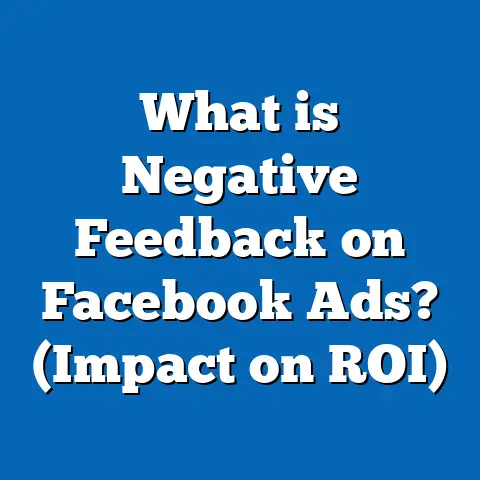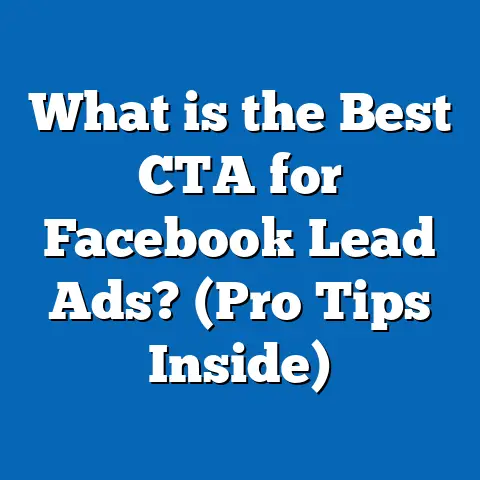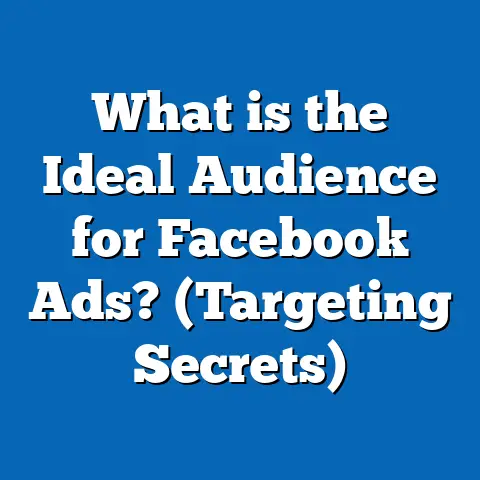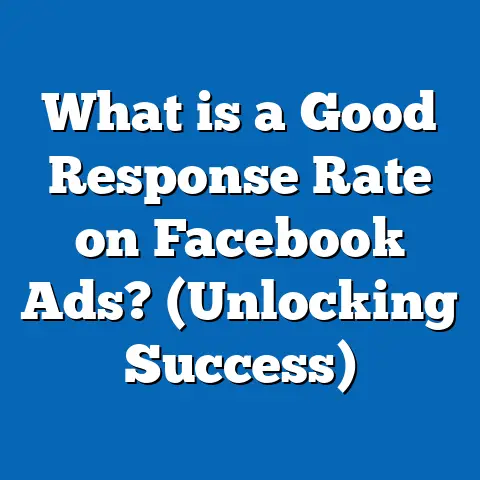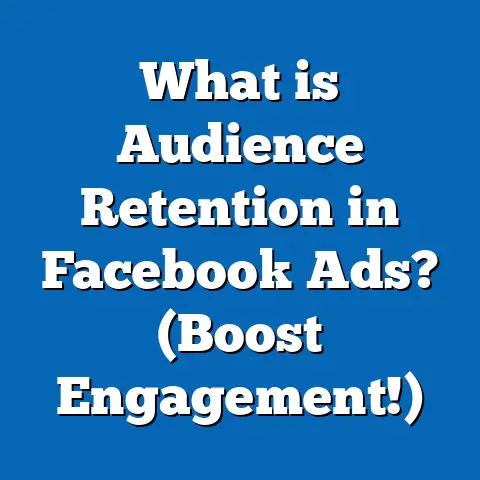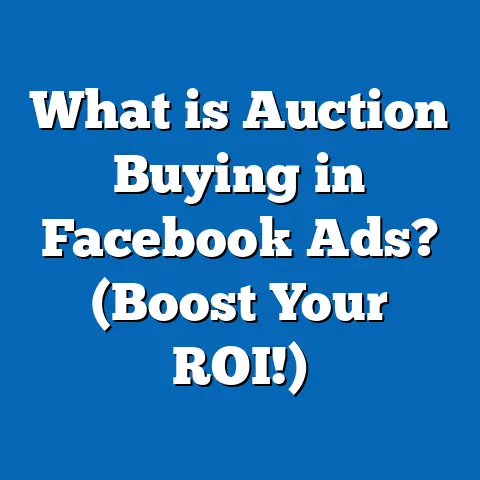What is a Facebook Ad Link Description? (Boosting Clicks)
What is a Facebook Ad Link Description? (Boosting Clicks)
Introduction: A Surprising Fact About Facebook Ads
Did you know that Facebook generated over $134 billion in ad revenue in 2023 alone? That’s nearly a quarter of all digital advertising spend worldwide. Despite this massive market share, many advertisers still miss out on the full potential of Facebook ads due to small but critical details. One such detail is the Facebook Ad Link Description.
While often underestimated, this small piece of text can dramatically influence how users interact with your ads. When used correctly, it can boost your ad’s click-through rate (CTR), reduce cost-per-click (CPC), and improve overall campaign performance.
Section 1: Understanding the Facebook Ad Link Description
What Exactly Is a Facebook Ad Link Description?
When you create a Facebook ad using the “link ad” format, your ad consists of several parts:
- Primary Text: The main message appearing at the top of the ad.
- Headline: A bold, attention-grabbing phrase below the primary text.
- URL Display: The web address or domain users will visit.
- Link Description: A smaller text appearing below the headline that provides additional context about the link.
The Link Description is designed to give users more information about what they can expect after clicking the link. It supports and complements your headline by clarifying the offer, value proposition, or next steps.
Visual Placement of Link Description
The link description appears immediately beneath the headline in your ad layout on desktop and mobile News Feeds, as well as on Facebook’s Audience Network placements. It is separate from both the primary text and headline but acts as an extension that helps make your ad message clearer and more compelling.
Why Should You Care About the Link Description?
Most advertisers focus primarily on headline and primary text, but this leaves out an important conversion lever. According to Facebook’s own research:
- Ads with well-written link descriptions experience up to 20% higher CTR compared to those without.
- A clear description reduces ambiguity, increases user confidence, and helps prevent wasted clicks.
- It can improve your ad’s relevance score, which influences how often your ad is shown and how much you pay for clicks.
Link Description vs. Other Text Elements: What’s the Difference?
| Element | Location | Purpose | Character Limit (Approx.) |
|---|---|---|---|
| Primary Text | Top of the ad | Main message or story | Up to 125 characters (recommend shorter for mobile) |
| Headline | Below primary text | Attention grabber, summarizes offer | Around 25 characters |
| URL Display | Below headline | Shows web address | Variable |
| Link Description | Below headline (smaller font) | Adds supporting detail or call to action | Around 30 words |
Section 2: The Psychology Behind Link Descriptions
Understanding why link descriptions matter requires insight into how users process information on social media.
How Users Read Facebook Ads
Eye-tracking studies from Nielsen Norman Group show that social media users scan rather than read thoroughly. Their attention spans are short—typically less than 8 seconds per ad.
When scrolling quickly through their feeds:
- Users first notice visuals (images/videos).
- Then they glance at headlines.
- Supporting text like link descriptions help confirm relevance if users pause to consider clicking.
Reducing Cognitive Load
The brain prefers simple, clear information to make quick decisions. Ambiguous or missing details create cognitive friction, causing hesitation.
A well-crafted link description reduces this friction by:
- Clarifying what’s being offered
- Explaining benefits in simple terms
- Providing reassurance about the next step
This leads to more confident clicks.
Trust and Credibility
Facebook users are cautious about clicking links. Suspicious or unclear ads often get ignored or generate negative feedback.
Including transparent and honest link descriptions builds trust:
- Users feel they “know what to expect.”
- Reduces perceived risk of wasting time or falling for misleading ads.
Section 3: Data-Backed Insights on Facebook Ad Link Descriptions
Impact on Click-Through Rate (CTR)
A comprehensive study by WordStream analyzed over 256 million Facebook ads to identify key drivers of CTR. Their findings showed:
- Ads with detailed link descriptions averaged a CTR of 1.91%.
- Ads without a link description averaged just 1.12% CTR.
- This represents a 70% increase in CTR when including relevant descriptions.
Influence on Cost Per Click (CPC)
Facebook’s ad auction system rewards ads that deliver better user engagement. Higher CTRs signal relevance and quality, which leads to:
- Lower CPC due to better ad placement.
- More cost-effective campaigns overall.
Facebook reports that well-crafted link descriptions can reduce CPC by around 15%, translating into significant budget savings over time.
Conversion Rate Correlation
While CTR is important, actual conversions matter most. According to a case study by AdEspresso:
- Ads with clear descriptions saw a 12% higher conversion rate compared to those without.
- This is because users clicking are more qualified—better informed and more likely to complete desired actions (purchase, signup).
Mobile vs. Desktop Performance
Mobile devices account for over 94% of Facebook’s active users. Mobile screens have less space and users scroll faster.
Social Media Examiner found that concise and benefit-driven link descriptions increase mobile CTR by approximately 12%, by quickly communicating value before users decide.
Section 4: Technical Breakdown – How Facebook Uses Link Descriptions in Its Algorithm
Facebook’s Relevance Score and User Engagement
Facebook assigns each ad a “relevance score” based on predicted user engagement and feedback. Key factors include:
- CTR
- Positive feedback (likes, shares)
- Negative feedback (hides, reports)
- Historical engagement patterns
The link description contributes indirectly by making the ad clearer and more relevant, boosting engagement signals that feed into this score.
Impact on Ad Delivery and Costs
Higher relevance scores mean:
- Your ads get shown more often.
- You pay less per click or impression.
- Your overall campaign performance improves.
Ignoring this small text field can cost you in terms of reach and budget efficiency.
How to Add/Edit Link Descriptions in Ads Manager
- Go to Facebook Ads Manager.
- Create a new campaign or edit an existing one.
- Select “Traffic” or “Conversions” objectives for link ads.
- Choose the “Single Image or Video” or “Carousel” ad format.
- In the ad creation section, find the “Link Description” field below the headline.
- Enter your description (25-30 words recommended).
- Preview mobile and desktop versions before publishing.
Section 5: Crafting Effective Facebook Ad Link Descriptions – Best Practices
1. Keep It Clear and Concise
Avoid complicated language or unnecessary words. Your description should be easy to understand at a glance.
Example:
Headline: “50% Off Summer Shoes!”
Link Description: “Shop our limited-time sale with free shipping on all orders.”
2. Highlight Benefits and Value
Focus on what users gain from clicking or purchasing.
Example:
Headline: “Join Our Marketing Webinar”
Link Description: “Learn proven strategies to boost sales in just one hour.”
3. Use Strong Action Verbs
Encourage immediate action with verbs like “Discover,” “Get,” “Save,” “Explore,” or “Learn.”
Example:
Headline: “Download Our Free E-book”
Link Description: “Get expert tips for growing your business today.”
4. Match Audience Language and Tone
Tailor tone based on your target demographic’s preferences — professional for B2B, casual for lifestyle brands.
5. Avoid Overpromising or Misleading Claims
Honesty builds trust; misleading descriptions cause negative feedback and wasted clicks.
Section 6: Examples of Well-Written Facebook Ad Link Descriptions Across Industries
| Industry | Headline | Link Description |
|---|---|---|
| SaaS | “Try Our Project Management Tool” | “Get organized with features designed for remote teams.” |
| Retail | “New Summer Collection Available” | “Explore vibrant styles perfect for every occasion.” |
| Education | “Enroll in Digital Marketing Course” | “Gain skills from industry experts with flexible schedules.” |
| Travel | “Book Your Dream Beach Vacation” | “Exclusive deals on resorts and flights this summer.” |
| Health & Wellness | “Boost Your Immunity Naturally” | “Discover supplements backed by science for daily wellness.” |
Section 7: Case Studies – Real World Impact of Optimized Link Descriptions
Case Study 1: E-commerce Apparel Brand
Background:
A mid-sized fitness apparel company was running Facebook ads promoting a new product line but struggled with low CTR (~0.8%).
Experiment:
They tested two versions of their ads:
- Version A: No link description
- Version B: Added benefit-focused description — “Shop breathable, sweat-wicking fabrics designed for maximum comfort.”
Results:
Version B increased CTR by 35%, reaching 1.08%. CPC dropped by 12%, leading to improved ROAS.
Case Study 2: Online Course Provider
Background:
An online education platform advertised its digital marketing course but noticed many clicks didn’t convert.
Changes Made:
Optimized link descriptions with clear next steps — “Enroll now for lifetime access and expert support.”
Results:
Conversion rate increased by 18%, showing better-qualified clicks due to clearer expectations.
Section 8: Comparing Facebook Ad Link Descriptions with Other Platforms
Google Ads Descriptions vs. Facebook Link Descriptions
Google Ads depends heavily on description text appearing beneath headlines in search results. These often contain keywords targeting user intent.
Differences include:
| Aspect | Google Ads Description | Facebook Link Description |
|---|---|---|
| Length | Longer (up to 90 characters each line) | Shorter (~30 words recommended) |
| Purpose | Target search intent | Support engaging social media audiences |
| Placement | Below headline in search results | Below headline in News Feed and Audience Network |
Both require clarity but serve different user mindsets—active search vs. passive social browsing.
Section 9: Advanced Techniques for Maximizing Link Description Impact
A/B Testing Multiple Variations
Run split tests with different descriptions to identify language that resonates best with your audience.
Example variables:
- Benefit-focused vs. feature-focused
- Formal vs casual tone
- Including urgency words like “Now” or “Limited time”
Keyword Inclusion for Relevance
While not SEO-critical on Facebook, including relevant keywords related to your audience’s interests can enhance perceived relevance.
Alignment With Landing Page Content
Ensure consistency between your link description and landing page messaging to reduce bounce rates caused by mismatched expectations.
Use Dynamic Text Replacement Tools
Some advanced tools allow inserting user-specific data (location, name) into link descriptions dynamically for higher personalization.
Section 10: Common Mistakes to Avoid With Link Descriptions
- Leaving it blank: Missing opportunity for additional persuasion.
- Being too vague: Unclear descriptions cause hesitation.
- Overloading with information: Too long or complex texts get ignored.
- Misleading claims: Damages trust and triggers negative feedback.
- Ignoring mobile preview: Text may get cut off if too long on mobile devices.
Section 11: Tools and Resources for Writing Better Link Descriptions
- Facebook Ads Manager Preview Tool: Check how descriptions appear across devices.
- Grammarly: Ensure clarity and error-free writing.
- Headline Analyzer Tools: Use for headline-link description synergy.
- A/B Testing Platforms: Tools like AdEspresso or Hootsuite Ads Manager for split testing variations.
- Analytics Dashboards: Regularly monitor CTR, CPC, conversion rates with Facebook Insights and Google Analytics.
Section 12: The Future of Facebook Ad Link Descriptions
AI-Powered Copy Suggestions
Facebook has introduced AI tools that generate headline and description suggestions based on campaign goals and audience data. Leveraging these can speed up optimization but should be reviewed manually.
Increasing Mobile-Centric Design
As mobile usage grows, shorter, punchier descriptions will become even more critical.
Privacy Changes Impacting Ad Copy Strategy
With evolving privacy regulations (e.g., GDPR, CCPA), transparency in link descriptions will play a bigger role in building user trust amid limited tracking data availability.
Conclusion: Boost Your Clicks With Smart Use of Facebook Ad Link Descriptions
The Facebook Ad Link Description may seem like a small piece of your advertising puzzle but it plays a powerful role in influencing user behavior. Data proves that optimized descriptions lead to significantly higher click-through rates, lower costs, better conversion rates, and ultimately stronger return on investment.
For marketers and business owners aiming to maximize their Facebook campaigns:
- Don’t overlook this element.
- Invest time crafting clear, benefit-driven, concise descriptions.
- Test different versions regularly.
- Align messaging with landing page content.
- Monitor performance metrics closely.
By mastering your link descriptions alongside other ad components like headlines and images, you’ll unlock new levels of engagement and profitability from your Facebook advertising efforts.
If you want help creating tailored link description templates or need guidance on integrating these best practices into your existing campaigns, let me know!

